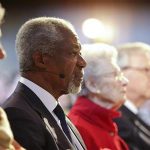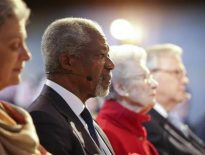(Reuters) – The United States and Japan announced on Thursday a revised agreement on streamlining the U.S.
military presence on Okinawa that will shift 9,000 Marines from the southern Japanese island to Guam and other Asia-Pacific
sites.

tarmac at Marine Corps Air Station Futenma in Ginowan on Okinawa May 3, 2010. REUTERS/Issei Kato
The new plan, unveiled days before Japanese Prime Minister Yoshihiko Noda meets President Barack
Obama in Washington, helps the allies work around the central but still-unresolved dispute over moving the Futenma air base
from a crowded part of Okinawa to a new site that has vexed relations for years.
“I am very pleased that, after many
years, we have reached this important agreement and plan of action. I applaud the hard work and effort that went into
crafting it,” U.S. Defense Secretary Leon Panetta said in a statement.
“Japan is not just a close ally, but also a
close friend.”
Under the agreement, 9,000 U.S. Marines will be relocated. Five thousand will go to Guam and the rest
to other sites such as Hawaii and Australia, a joint U.S.-Japanese statement said.
The updated
version of a long-delayed 2006 plan was needed to achieve “a U.S. force posture in the Asia-Pacific region that is more
geographically distributed, operationally resilient and politically sustainable,” the statement said.
Snags over
Okinawa had raised questions about the viability of the Obama administration’s strategy of shifting U.S. forces from other
regions to the Asia-Pacific to deal with nuclear saber-rattling by North Korea, the rapid military buildup of China and territorial disputes in the South China
Sea.
Friction over U.S. bases intensified after the 1995 gang rape of a Japanese schoolgirl by U.S. servicemen. The
case sparked widespread protests by Okinawans, who had long resented the American presence due to crime, noise and deadly
accidents.
There are about 47,000 U.S. troops in Japan under a 1960 bilateral security treaty.
Okinawa,
occupied by the United States from 1945-72, accounts for less than 1 percent of Japan’s total land but hosts three-quarters
of the U.S. military facilities in the country in terms of land area.
“This has been … bogged down for years, but
now we have been able to come up with a new approach de-linking the Futenma relocation from other elements, like moving out
Marine forces to Guam and returning some parts of Okinawa,” said Ichiro Fujisaki, Japan’s ambassador to the United
States.
“Things are going to start moving,” he told a gathering at a think tank in Washington.
Kurt Campbell,
assistant secretary of state for East Asian and Pacific Affairs, said the deal was discussed widely with U.S. lawmakers, who
had refused to fund the overhaul on Okinawa until the Futenma deadlock was resolved and the administration fully explained
how the move would fit overall U.S. strategy.
“We think it breaks a very long stalemate … that has plagued our
politics, that has clogged both of our systems,” said Campbell.
“REBALANCING” TOWARD ASIA-PACIFIC
A senior
State Department official said: “This is really a key component of our strategic rebalancing toward the Asia-Pacific
region.”
The new policy has also entailed closer U.S. military ties with the Philippines, Australia and
Singapore.
The agreement includes a $3.1 billion cash commitment from Japan for the move to Guam as well as for
developing joint training ranges on Guam and on Tinian and Pagan in the U.S.-controlled Northern Mariana Islands.
The
previous agreement on the move to Guam had Japan providing $6.1 billion in support, with $2.8 billion in cash and the rest in
financing arrangements. The two sides agreed to limit that to $3.1 billion from Japan because of the smaller footprint the
Marines will have in Guam
Campbell acknowledged that more work needed to be done, including finding a replacement for
Futenma.
Proposed replacement sites for Futenma on the subtropical island that lies between Japan’s main islands and
Taiwan have met strong local opposition. At the same time Tokyo was in political disarray, with six prime ministers in six
years.
“Does this agreement answer every question? It does not. Is there more programmatic and technical work that is
necessary? Yes,” said Campbell.
“But at a fundamental level, we think this agreement moves the ball very substantially
down the field in a way that no one would have anticipated a few months ago,” he said.
Separating the move to Guam
from the Futenma issue frees up the allies to work more on cybersecurity, space, intelligence, surveillance and
reconnaissance operations and ballistic missile defense, a senior U.S. Defense Department official said.
Senators Carl
Levin, John McCain and Jim Webb – top members of the U.S. Senate Armed Services Committee who had frozen Okinawa funding
until their budgetary and strategic questions were answered – said some of their concerns had been addressed.
“We
still have many questions about the specific details of this statement and its implications for our force posture in the
Asia-Pacific region,” they said in a statement, which also vowed to keep working on “a mutually beneficial, militarily
effective, and fiscally sustainable agreement” on Okinawa and Guam.
(Additional reporting by David Alexander; Editing by





